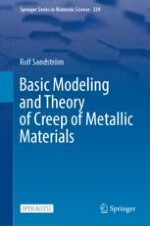11.1 General
11.2 Empirical Principles for Development of Creep-Fatigue Damage
11.2.1 Fatigue and Creep Damage
11.2.2 Loops During Cyclic Loading
11.3 Deformation During Cyclic Loading
11.3.1 Basic Model for Hysteresis Loops
11.3.2 Application of the Cycling Model
11.4 Cavitation
11.4.1 Nucleation of Cavities
Pre-creep | εtot, % | σrange MPa | Ncycl | Ninit | ncav 1/mm2 | Δσhold MPa | Δεhold × 10–2% | Δεcr_tens × 10–4% | Δεcr_cmpr × 10–4% |
|---|---|---|---|---|---|---|---|---|---|
No | 0.92 | 590 | 720 | 540 | 905 | 62 | 4.5 | 6.2 | −8.2 |
No | 0.64 | 559 | 1590 | 1283 | 1097 | 52 | 3.8 | 2.8 | −4.4 |
No | 1.2 | 655 | 490 | 348 | 173 | 86 | 6.3 | 9.7 | −13 |
No | 1.53 | 669 | 409 | 334 | 1156 | 91 | 6.7 | 14 | −18 |
Yes | 0.55 | 447 | 1710 | 1489 | 3202 | 60 | 4.4 | 4.3 | −6.5 |
Yes | 0.83 | 494 | 671 | 568 | 3359 | 79 | 5.8 | 9.1 | −14 |
Yes | 1.11 | 502 | 576 | 517 | 2233 | 82 | 6.0 | 15 | −21 |
11.4.2 Cavity Growth
11.5 Summary
-
Many plants that are operating at high temperatures are exposed to both creep and fatigue. A number of fossil-fired plants are running under intermittent loading while in the past they were adapted to base loading. The reason is that renewable sun and wind units do not supply power continuously and have to be backed up by conventional plants. As a consequence, fossil-fired power plants experience often combined creep and fatigue loading nowadays.
-
Numerous empirical methods are available for assessing the material damage in plants. The classical Robinson’s and Miner’s damage summation rules have been extensively tested. Some results suggest that the damage typically can vary from being underestimated by a factor of three to being overestimated by the same factor. From a practical point of view such a large uncertainty is not acceptable. To base damage assessment just on mechanical properties is consequently difficult. It is also important to analyze the changes in the microstructure such as particle and substructure coarsening and formation of creep cavities and compare these findings with models. In this respect continuum damage mechanics can be quite useful.
-
Many empirical models for damage assessment can predict both the development of mechanical properties and the microstructure. However, as for all empirical models, they have to be adapted to specific cases to give meaningful results. The alternative is to use basic models for both mechanical properties and microstructure. Such models are readily available also for the development of the microstructure as described in this book. Although basic models are somewhat more complex to program, the predictions are far safer.
-
For analyzing creep damage, the assessment of cavitation has been quite useful. In recent years basic quantitative models for cavitation have been established that are directly applicable in this context. However, the situation has been different for cyclic loading. Two essential features have been missing. Prediction of stress strain loops has been based on empirical approaches meaning that the results are restricted to the experimental case(s) under investigation. It is demonstrated in this chapter that many of the basic models applied in non-cyclic situations can be transferred to cyclic cases. The main parameter that has to be changed is the dynamic recovery constant. The reason for this is simple. During cyclic deformation dislocations encounter each other much more frequently than in monotonous cases and it increases the rate of recovery. Therefore, the recovery constant must take a higher value.
-
The other missing feature has been the absence of models for the development of cavitation. It is expected that cavitation plays the same important role during creep-fatigue interaction as during plain creep. With the help of the models for the stress strain loops, the amount of creep strain in each cycle can be computed. By applying this in the formula for cavity nucleation, the number of cavities after LCF and after combined creep and LCF for a 1Cr0.5Mo steel have been possible to compute in an acceptable way.
-
The cavity growth rate for the 1Cr0.5Mo steel has also been analyzed. Both models for diffusion controlled and strain controlled growth have been considered. Since quite small creep strains appear in each cycle unconstrained diffusion growth has been used. The reason is that it is assumed to be unrealistic that equilibrium between the cavity growth and the creep deformation could be established. The strain controlled growth is based on the assumption that the amount of growth is equal to the amount of grain boundary sliding. This assumption has previously worked well for two steels during creep where data are available. Although the diffusion growth is faster initially, the total growth is about the same as for strain controlled growth of the 1Cr0.5Mo steel. The final cavity size is in the interval from 0.1 to 1 µm, which seems reasonable. These results should be considered as tentative since detailed experiments are not available.
-
It is often assumed that some closure of cavities takes place during the compression part of the load cycle. With the help of the model for diffusion controlled growth, it should in principle be possible to predict the amount of closure. Unfortunately, meaningful results are not obtained unless special assumptions are made. Therefore, the amount of cavity closure remains an open issue. In the prediction of cavity nucleation for 1Cr0.5Mo, no account of cavity closure has been taken into account. Satisfactory predictions have been obtained anyway indicating that the amount of cavity closure must be limited.
